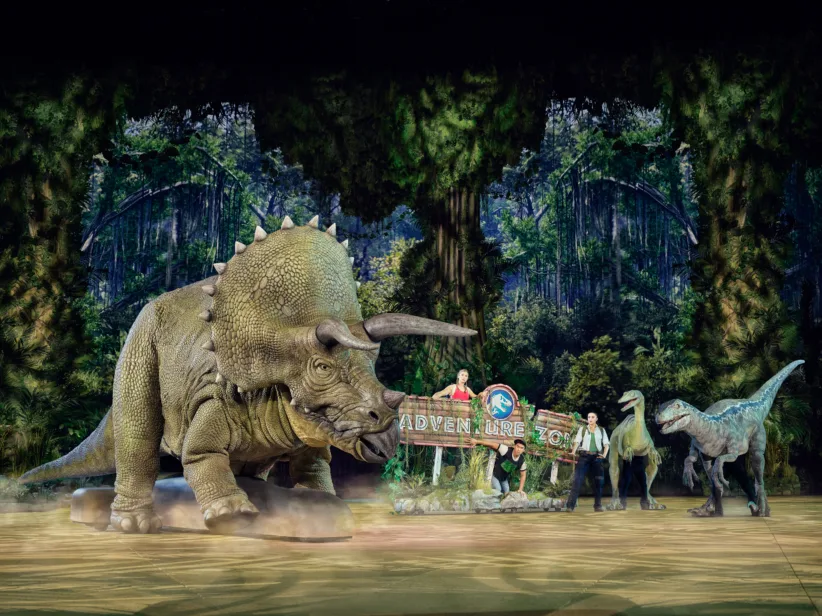Stand in line for pizza? You must be kidding, I thought as I approached Pepe’s Pizza on Wooster Street in New Haven, Connecticut. I looked at the 20 or so people standing on the sidewalk in front of us, and then at 7-year-old Ross, who hardly has the patience to wait for me to put dinner on the table when he’s hungry. Then I looked at Peter, my husband, who hates to stand in line. He once refused to queue up to see Michaelangelo’s David in the Galleria dell’ Accademia, in Florence, preferring to stand outside with Ross in a stroller while I took our two older sons in to see David in all of his white, naked glory. Now Peter seemed fine at the prospect of waiting in line. For about 30 minutes, we snaked along the sidewalk, getting nearer and nearer to the pizza shop that has made New Haven famous.
A cornucopia of culture New Haven is famous for many things, we learned during our three-day visit there. Besides being the home of Yale University, New Haven and its surrounding towns offer visitors a cornucopia of historic, cultural, and outdoor experiences that make it a stand-out among communities its size. A tour of the Yale campus is a good starting point. Even Ross enjoyed walking among its stately buildings and towering trees. We met another family with a toddler at an outdoor sculpture by Yale alumna Maya Lin, known for her Vietnam War Memorial in D.C. This sculpture, called the ‘Women’s Table’, commemorates the university’s progress toward co-education, which was only fully achieved in 1969. The sculpture’s strength is in its simplicity: a huge round granite table covered by a thin sheet of running water, and underneath inscribed numbers showing the ever-increasing enrollment of female students during Yale’s 300-year history. Of course, Ross and the little boy we met weren’t interested in the historical importance of the sculpture. They just delighted in splashing the water around. Even we grown-ups couldn’t resist sliding our hands along the smooth granite surface, enjoying the cool water on our palms on a hot August afternoon. Families with older children will enjoy an in-depth tour of Yale, but we chose just to stroll through its attractive grounds, stopping occasionally to admire its Gothic architecture or to rub the toes of former Yale president Theodore Woolsey’s statue, a good-luck tradition for students, especially at exam time. Yale is also home to outstanding museums, including the Peabody Museum of Natural History, which offers dinosaur exhibits sure to please kids of all ages. Older children will appreciate the bounty of art on campus, including works by French Impressionists, as well as the largest collection of British art outside of Britain. Another attraction is the Beinecke Rare Book and Manuscript Library, which houses a Gutenburg Bible, as well as original manuscripts by some of the world’s greatest authors. Being an outdoorsy family, however, we decided to forgo the dinosaurs and the dusty books, and instead opted to spend as much time outside as we could, enjoying the lovely summer temperatures. The Greater New Haven area offers a variety of options for exploring nature, we soon discovered.
Casting a spell A myriad of trails, most of them shaded, attracts hikers of all ages to Sleeping Giant State Park, just north of New Haven in the town of Hamden. The park is so named because, from a distance, its two foothills resemble the belly and head of a sleeping giant. We hiked the 1.6 mile Tower Path to its summit, where a Stone Tower reaches to the sky. It dates back to FDR’s WPA program, when the tower and the trail were built, along with so many other park trails and attractions nationwide. Recently renovated, the tower provides wheelchair access (as does the trail itself), and offers far-reaching views to those who climb to the top. After our hike, we relaxed in the picnic area, enjoying fruit and cold drinks. Nearby, an extended family of 20 or so Native Americans picnicked. Surrounding the base of a nearby tree were a dozen or so ornately carved walking sticks, which Peter wanted to photograph. One young man said, “No photos,” but Peter glanced over at the elder, who nodded his permission. This park and the surrounding region were home to the Quinnipiac Indians, who have their own legend about the Sleeping Giant. In their version, he’s actually a spirit who fell asleep after a spell was cast over him. While a nap sounded tempting to us after our hike, we were on a limited schedule and rallied onward to our next adventure. In the middle of New Haven, we found a peaceful oasis, the West River, one of three rivers that empty into Long Island Sound at the New Haven harbor. The city has created a wonderful program called Canoe New Haven, which offers free canoe trips from May through October on its three rivers: West, Mill, and Quinnipiac. Reservations aren’t required; all you have to do is show up at the launching site during designated hours and wait your turn. After donning a lifejacket and grabbing a paddle, you’ll set off in a colorful canoe with a volunteer guide who’ll teach you about conservation and wildlife during your two-mile scenic loop. I was fortunate to be in a canoe guided by Peter Davis, a tanned 46-year-old outdoorsman who’s known locally as the River Keeper. In fact, Peter was instrumental in helping start the Canoe New Haven program eight years ago; he’s now employed by the city to run the program. Peter cares deeply about the rivers and considers it his mission to educate people, especially school groups, about nature and the environment. And it turns out the West River was not always the tranquil, attractive place it is today. Sixteen years ago, Peter and a growing group of volunteers began cleaning up New Haven’s rivers, which had become dumping grounds for everything from tires to shopping carts. “We’ve removed eight million tons of trash,” he said proudly. “We even pulled out a piano once.” As we paddled along, Peter pointed out shore birds that live in the bordering marshlands. Birds are a good barometer of water quality, he explained, adding that they are a recent addition to the area. We watched people fishing and crabbing along the river banks, and I could sense the pride Peter feels when he sees people enjoying the river and its bounty one again. After our canoe adventure ended, we headed over to Lighthouse Point Park, a favorite gathering spot for families. A sandy beach, picnic tables, and playgrounds make this a perfect place to wile away a summer day. One of the park’s attractions is a vintage carousel housed in a wooden pavilion right by the shore. The building is frequently rented for parties and festive events, and as we waited to board the carousel, preparations were under way for a wedding ceremony and reception in this lovely seaside setting. As the sea breeze blew through the open doors and windows, Ross and I climbed aboard the carousel’s painted ponies — with names such as Sea Dreamer, Patches, Moonstar, Lollipop, and Sunflower — for a twirling ride down memory lane.
Ahoy, landlubbers! Another highlight of our visit was an afternoon sail on the two-masted schooner called — I can finally say it almost as well as the locals — the Quinnipiac, an 84-foot replica of an 1880s Mississippi cargo schooner with an adjustable centerboard. In addition to sunset cruises more suited to a grown-up crowd, the Quinnipiac offers a public educational sail popular with families, that includes hands-on learning activities. During the sail, we were invited to participate in chores, such as raising and lowering the sails and bringing in a trawl net. The crew did a great job of instructing us landlubbers on proper sailing etiquette and terminology, as well as safety. Randall, the first mate, explained what the boom is and why it’s called that. “It’s the sound the boom makes when it hits your head,” he said, with a grin. Jeanne, a friendly blonde, taught us how to haul in the trawl net. “Haul away. Don’t move your feet, just your hands. Hand over hand,” she patiently reminded us. Melanie, the on-board educator, set up a Touch Tank on deck, where she placed the sea creatures brought up in the trawl net. The children were mesmerized by the crabs and fish. The horseshoe crabs were a big favorite, and Ross relished the chance to hold these strange creatures. Of course, all this outdoor activity can make a family ravenous. Fortunately, New Haven has a variety of restaurants to suit all tastes and budgets. In fact, with so many students among their clientele, most restaurants offer fare at very reasonable prices. At the higher end of the spectrum is a delightful seafood restaurant called The Rusty Scupper, where we dined one evening. Sitting seaside on a covered deck, we not only enjoyed fresh seafood, but also the sights and sounds of the harbor during our dinner. I was hankering for lobster, and I wasn’t disappointed. A 1 1/2 pound crustacean, perfectly steamed, arrived nestled on a platter beside a handy bib, which I tied on to catch the drips of butter. Peter found his grilled tilapia with lobster mashed potatoes to his liking, and Ross was totally happy with — what else — a hamburger from the kids’ menu. The Rusty Scupper is also known for its Sunday brunch, featuring the freshest seafood and a lively jazz combo. Besides its New Haven location, The Rusty Scupper can also be found in Baltimore. Sophisticated city restaurants abound in the vicinity of New Haven’s famous Green, a central park which features concerts during warm weather months. Rumor has it many local eateries rival New York City’s finest — restaurants such as Roomba, which offers Latino fusion cuisine; Union League Cafe, which specializes in continental fare; and Hot Tomato’s, where we sampled a lovely, late-night tiramasu. We’d hoped to try a hamburger at Louis’ Lunch, a landmark restaurant which served America’s first hamburger 101 years ago, but it closes down each August. Back across town on Wooster Street, a dozen or so Italian restaurants all claim to be the best around. We couldn’t try them all, but we did enjoy crusty old-world bread at Abaté’s Restaurant, and luscious lemon Italian ice at Libby’s. Our best dining experience occurred at Pepe’s, known as America’s first pizza restaurant, the one we waited in line for, the one that we were told would be well worth the wait. And was it? Was it ever. As one who’s used to eating thick, chewy pizza crust, I found Pepe’s pizza to be a different breed altogether. Light, crisp crust complemented but didn’t overpower the quality ingredients perched on top. Peter and I ordered a pizza with white clam sauce, which we were told is Pepe’s signature pie, and a pepperoni pizza for Ross. When our order finally arrived, we ate greedily — we’d been waiting in line for half an hour, remember? This pizza was so good, it actually melted in our mouths; we barely needed to chew. The clam pizza was simple but robust with large bits of clams and almost-as-big bits of garlic bathed in olive oil.
To request tourist information, call the Greater New Haven Convention & Visitors Bureau at 800-332-7829 or visit www.newhavencvb.com. Be sure to ask about the family package, which offers special savings.





















